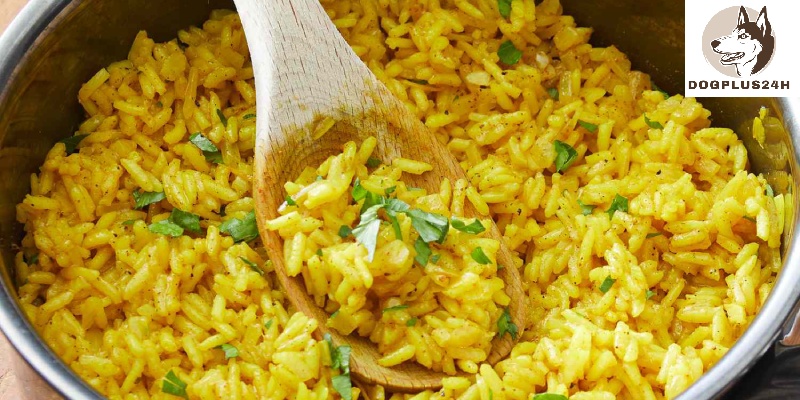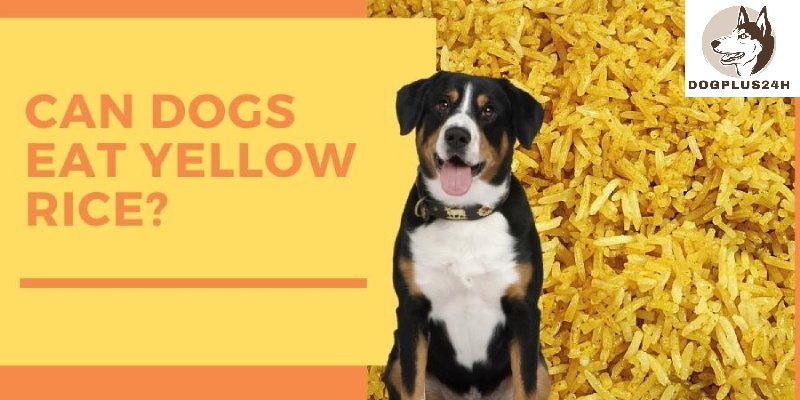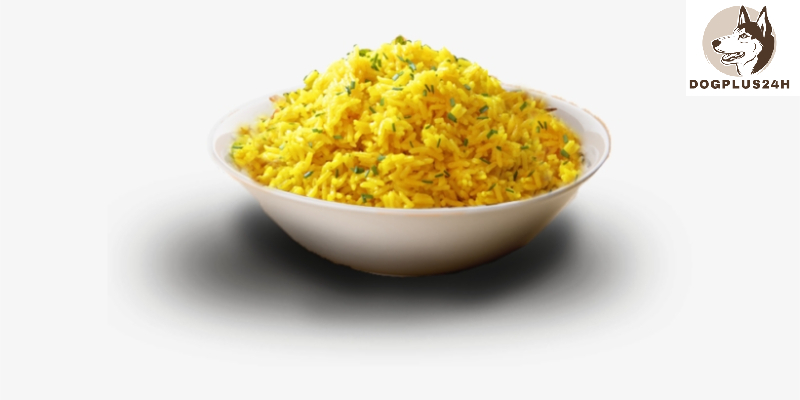Can dogs eat yellow rice? This is a common question when we share our meals with our canine pals. While it’s natural to want to treat our dogs to something special from our own plates, it’s critical to ensure that what we serve them is both safe and nutritious.
Yellow rice often seasoned with spices, may appear to be a delightful option, but is it suitable for our canine companions? In this post, we’ll look at the nutritional benefits and potential concerns of feeding yellow rice to dogs, so you can make an educated decision about what’s best for your four-legged family member.
What is yellow rice?

What Is used to make yellow rice?
Yellow rice is the basis for white rice. Only the specified spices are used in this recipe to turn white rice into yellow rice. Turmeric, saffron, and annatto are the three most popular spices.
Turmeric
Turmeric is the most important spice for creating golden rice. Most veterinarians believe that the amount of turmeric used in cooking is safe for dogs.
Saffron
Saffron is another element in yellow rice. It’s also commonly used in cooking to turn rice yellow. Saffron in trace amounts is safe for your dog. But if used in large amounts, it will be extremely dangerous to your dog’s life.
Annatto
Yellow rice is made with annatto spice. It’s popular in South and Central America, but not as much as turmeric or saffron.
Is Turmeric safe to eat for your dogs?
Turmeric has numerous health benefits for pets. It contains anti-inflammatory substances like curcumin, which is beneficial for dogs with joint inflammation or arthritis. However, do not feed turmeric to your dog for any other condition.
According to research, the anti-inflammatory component is particularly beneficial for dogs with movement impairments and functions as an antioxidant, among other things. Given that your pet does not consume big quantities of it. Some dogs may be intolerant to turmeric; therefore, if this is the first time you’ve given it to them, keep an eye on them.
Turmeric is also best taken with a little cooking oil for dogs that have digestive issues. This is because it might be difficult for dogs with digestive issues to digest.

Is Saffron safe to eat for your dogs?
Is Annatto safe to eat for your dogs?
Annatto is an orange-red food coloring or spice derived from the Achilles tree (Bixa Orellana) seeds. Annatto is also used as a spice to improve the flavor of food due to its somewhat sweet and spicy flavor. It is widely used as a medication for various skin and eye issues. An adult may take 750 mg of annatto daily as medicine. Itching, low blood pressure, edema, stomach ache, hives, and other adverse effects are possible.
This spice is never suggested for dogs for a variety of reasons. However, there is no danger in unexpectedly offering a small amount to the dog. Many veterinarians agree.
Can dogs eat yellow rice?
Golden rice is a nutritious addition to the diets of dogs, cats, and other animals. Because of its nutritional richness and adaptability, it is frequently used as the foundation for dog recipes. Yellow rice contains the same amount of protein as white rice but also has additional fiber and minerals.
Because of the high fiber level, it is simpler for your pet to digest than white rice, which can cause digestive issues in certain dogs. It also contains trace amounts of vitamin B12, which aids in the maintenance of your pet’s energy levels.
Golden rice is a variety of rice that has been genetically modified to be high in protein, making it ideal for dogs. Here’s why it’s a terrific method to supplement your dog’s diet with vitamins and minerals but keep in mind that it’s not necessarily better than white rice; they’re just different.
However, you must avoid feeding your dog too much golden rice because turmeric, cashew, and saffron can cause some side effects in dogs and can be fatal if given in high doses. Yellow rice can be turmeric or saffron and can contain other spices such as onions, garlic, ginger, cloves, shallots, green onions, and so on. So you’ll want to make sure you don’t overdo it with this ingredient.
Can dogs eat yellow rice? Turmeric powder is indicated for dogs at a dose of 2-3 teaspoons per day (1 teaspoon for 10 pounds of body weight). However, if your dog has a medical condition or is pregnant or nursing, consult with your veterinarian before introducing turmeric, cashews, or saffron into her diet.

Yellow rice seasonings can be poisonous to dogs. If your dog overeats, he may vomit or have diarrhea. If dogs swallow significant amounts of annatto seeds, they may experience serious side effects such as tremors, seizures, and even death.
Saffron, on the other hand, might produce stomach issues in dogs. Turmeric and annatto, at excessive dosages, can cause liver damage in dogs.
What kind of rice can dogs eat?
Rice is an excellent source of energy and nutrition for dogs, as well as being delicious. If you have a little dog who eats everything in sight, try incorporating rice into their diet as a treat or as part of mealtime.
Dogs can eat any type of rice they choose as long as they don’t have a food allergy or intolerance, but they should be given in moderation. Because dogs are carnivores, they require meat-based diets to keep healthy and energetic.
If your dog only eats rice or eats too much of it, it may develop stomach problems and malnutrition. So, if you’re giving your dog rice for lunch or supper, make sure it’s a reasonable amount and that you’re not overfeeding them.
If you’re giving your dog cooked rice, make sure he has enough fresh water to drink as he eats. This is an excellent approach to keep him hydrated and avoid intestinal problems.
You should also consider feeding your dog a low-fat or no-cholesterol food that will put less strain on his system, such as this yellow rice. This will help him keep his body running smoothly and avoid problems like diarrhea or constipation.
How to cook yellow rice for your dog?
Can dogs eat yellow rice? Golden rice is a rich source of protein and complex carbohydrates, essential for a healthy diet. It can be prepared in many ways to suit your dog’s taste and dietary needs. To prepare golden rice, you will need:
- 1 cup of water
- 2 tablespoons of butter
- 1/4 cup of salt
- 1/4 cup of pepper
In a saucepan, bring the water, butter, salt, and pepper powder to a boil. Cook for 15 minutes, or until the rice has absorbed all of the water.
Just make sure you’re using a recipe that takes your dog’s dietary needs into account. You don’t want to make them sick by allowing them to eat anything they shouldn’t. These things are critical for the overall health and well-being of dogs.
What to do if your dog accidentally eats yellow rice?
Check the list of ingredients used to produce golden rice first. If you notice anything possibly dangerous, contact your veterinarian right away.
In addition, keep an eye out for any signs of food illness in your dog. Look for vomiting, diarrhea, lethargy, dehydration, lack of appetite, tremors, seizures, loss of coordination, and collapse in your dog. The intensity of these symptoms will vary depending on the substances utilized, the child’s size, the amount of food consumed, and the sensitivity of the stomach.
Bottom line: When feeding your dog rice, stick to brown rice or cooked white rice. Although golden rice can provide him with nutrients, eating it can also bring additional health hazards.
FAQs – Can dogs eat yellow rice?
Is yellow rice healthy for dogs?
Because turmeric has anti-inflammatory effects, yellow rice may give some possible health benefits for dogs. However, it must be used sparingly and under the supervision of a veterinarian or certified animal nutritionist.
Can yellow rice cause stomach upset in dogs?
A high intake of rice, even yellow rice, can induce gastrointestinal discomfort in dogs, especially if they have a sensitive stomach or a history of digestive problems.
How should I feed yellow rice to my dog?
Yellow rice should be prepared simply, with no flavors or substances that may be harmful to dogs. It can be provided as a treat or as part of a balanced diet, although there are other sources of nourishment for dogs.
Can dogs eat Vigo yellow rice?
Vigo yellow rice has a nice flavor, however, it’s a little too salty for dogs. Dogs definitely require salt in their bodies for electrolyte balance, but only in trace amounts. It is not suggested that dogs consume salt or salty foods as this can result in salt sickness.
In conclusion
Yellow rice is a common element in many cuisines and can be served as a side dish or as a main course. This is a healthy alternative to white and brown rice that can be substituted in most recipes.
Can dogs eat yellow rice? Yellow rice should be fed to your dog in limited amounts because its spices (turmeric, cashew, or saffron) can be hazardous to dogs if consumed in large quantities. If your pet consumes yellow rice and develops symptoms such as vomiting, diarrhea, or lethargy, contact your veterinarian immediately.


